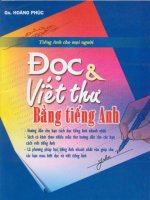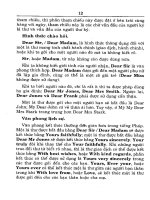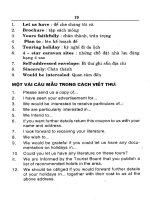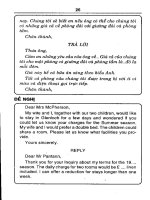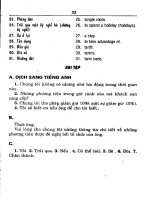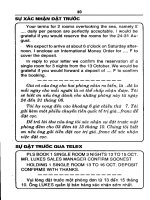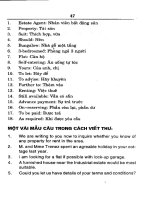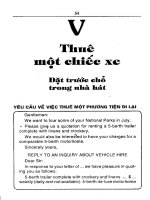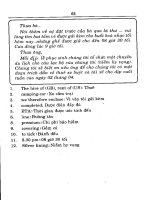Read Write Now Learner Workbook 2
Bạn đang xem bản rút gọn của tài liệu. Xem và tải ngay bản đầy đủ của tài liệu tại đây (1.15 MB, 186 trang )
READ
WRITE
Supporting the TV series
NALA
NOW
2
Learner Workbook
Page 1
Contents
Page
Introduction to Learner Workbook 6
Guidelines for Use 7
The Euro 8
Section 1: First aid 9
Reading Leaflets 11
Reading Instructions 12
Writing a List 14
Writing a Conversation 15
Reporting an Accident 16
Taking Down Instructions 18
Reading: Paperclips, Beds & Pencils 19
Spellings: Word Ending -ing 20
Crossword 22
Section 2: Cooking 23
Reading Recipes 25
Alphabetical Order 28
Reading an Index 29
Sentences 30
Writing Lists 31
Ordering 32
Reading: The History of Cooking 33
Spellings: Word Endings 34
Wordsearch 36
Section 3: Football 37
Reading Football Tables 39
Capital Letters 41
Reading an Index 42
The Local Directory 43
Reading 44
Working on Words 45
Writing a Football Report 46
Reading: An Interview with a Bohemians Fan 47
Spellings: Compound Words 48
Crossword 50
Page 2
Section 4: Gardening 51
Reading Instructions 53
Locating Information 54
Making Garden Compost 56
Taking Notes 58
Filling in Forms 59
Reading: Tulip Mania 60
Spellings: Word Building and Revision Sheets 61
Wordsearch 64
Section 5: Wedding 65
Reading Leaflets 67
Choosing Menus 68
Using a Diary 69
Wedding Invitations 70
-tion Words 72
Capital Letters and Full Stops 73
Writing a Cheque 74
Reading: Joe’s Wedding 75
Spellings: Spelling of Numbers 76
Crossword 78
Section 6: Accommodation 79
Looking for a Flat 81
Reading am and pm 82
Reading the Property Section 83
Filling in Forms 84
Moving into a New Flat 86
Writing Directions 87
Writing 88
Reading: Flatmates from Hell 89
Spellings: Apostrophe 90
Wordsearch 92
Contents
Page 3
Section 7: Information technology 93
Computers 95
The Email 97
Writing an Email 98
International Dialling Codes 100
Working on Words 101
Reading: Computers are Watching You! 103
Spellings: Syllables 104
Crossword 106
Section 8: DIY 107
Reading Instructions 109
Working on Words 111
Alphabetical Order 112
Finding Information 113
Reading Signs 114
Building Sentences 115
Writing 116
Reading: Feng Shui 117
Spellings: Revision Sheets 118
Wordsearch 120
Section 9: Healthy lifestyle 121
Changing Your Lifestyle 123
Reading Food Labels 124
The Food Pyramid 126
Vitamins 128
Per Cent 130
Reading: Changing to a Healthy Lifestyle 131
Spellings: -er, -ed, -ing 132
Crossword 134
Contents
Page 4
Section 10: Interview for a job 135
Writing Letters 137
Reading Job Adverts 138
Filling in Forms: Work History 140
Proof Reading 142
Using the Dictionary 143
Questions and Answers 144
Reading: Going for an Interview 145
Spellings: Hymonyms 146
Wordsearch 148
Section 11: Pets 149
Reading Notices 151
Talking to a Vet 152
Locating Information 154
Filling in Forms 155
Plurals: Changing -y to -ies 156
Reading Signs 157
Keeping a Pet 158
Reading: Unusual Animals 159
Spellings: Prefixes 160
Crossword 162
Section 12: Trip away 163
Following Directions 165
The Map of Ireland 166
Reading a Map 168
Road Signs 169
Making a List 170
Writing a Postcard 171
Reading: Following Instructions 172
Spellings: Revision Sheets 174
Wordsearch 176
Answers 177
Contents
Page 5
Copyright © 2001 National Adult Literacy Agency
ISBN 1-871737-12-5
Published by: National Adult Literacy Agency (NALA)
76 Lower Gardiner Street
Dublin 1
Telephone: (01) 8554332
Fax: (01) 8555475
Webpage: www.nala.ie
e-mail:
Writers: Pauline Hensey and Maureen Neville
Printer: Genprint
We wish to thank the following for the use of their material:
An Post, Batchelors Ltd., Beiersdorf Ltd., New Island Books Ltd., Nivea
Photographs were supplied by the TV production company AV Edge.
Thanks to Tommy Byrne, Gemma Lynch, Denise Quinlan, Oisin Quinlan
Thompson and Whoopee Scott (the dog) for being photographed.
Permission is given to reproduce parts of this publication for educational
purposes only. Any other users must seek permission to reproduce material
through the publishers.
Page 6
This Learner Workbook is written to support the TV series Read Write
Now 2. The book is split into 12 sections. Each section has 12 worksheets.
TV series
RTÉ 1 will show Read Write Now 2 from 19th September 2001 on:
•Wednesday nights at 7.30 pm
• Sunday mornings at 10 am
•Tuesdays at midnight.
Freephone support line:
• Ring the freephone support line number at 1800 20 20 65
• Literacy tutors are available Monday to Friday, 10 am to 4 pm
•It is a free and confidential information service
•Answer your questions or help you with the worksheets.
Local literacy service:
There are 126 VEC adult literacy schemes throughout the country. People
join their local literacy schemes to work with tutors on a one to one basis
or in small groups. The service is free and confidential. You can get 2 – 4
tuition hours per week. The local adult literacy organiser will meet you
and find a suitable tutor for you. There are about 17,000 adults learning in
literacy schemes around the country. There are 4,300 adult literacy tutors
working in literacy schemes and they are trained by their local literacy
service
For information on your nearest service contact us:
freephone line at
1800 20 20 65 (Monday to Friday 10 am – 4 pm)
or
NALA at (01) 8554332 (Monday to Friday 9.30 am – 5 pm)
Introduction to Learner Workbook
Page 7
This book is split into 12 sections based on the TV programmes. Each
section has 12 worksheets. They should be used soon after watching the
TV programme.
Each section begins with
• an introduction giving a brief summary of the TV programme
• the areas the worksheets will cover.
The following symbols will guide you through using the book.
Read
Write
TIP
Information
You will also receive a Support Book which contains information that is
often useful to have at hand, for example,
• when to use capital letters
• calendar
• words in forms
It also contains a word diary so you can write in new
words for yourself.
You will see this sign,
e, in all the worksheets dealing with sums. This is
the sign for the euro. The euro is the money that will be used in Ireland
from 1st January 2002. One euro is worth just under 79p in Irish money.
So for a rough way to turn Irish money into euros, just divide by 4 and
multiply by 5.
i
TIP
✍
Guidelines for use
Page 8
The Euro
Money is important to all of us no matter how much you have! Next year
our money will be changing from pounds and pence to euros and cent.
The first step is to get to know each coin, what it is called and what it
looks like. For each coin we have now, there is a matching coin in the
euro money.
There are 6 ‘pence’ coins up to £1: 1p, 2p, 5p, 10p, 20p, 50p, £1.
The pound is worth a hundred pence.
There are 6 ‘cent’ coins up to 1 euro: 1c, 2c, 5c, 10c, 20c, 50c, e1.
The euro is worth a hundred cents.
Here are the new euro coins.
aa
1£1
50c 50p
20c 20p
10c 10p
5c 5p
2c 2p
1c 1p
The pounds and pence will be
taken away gradually after the
1st January 2002.
Page
PROGRAMME
2
Cooking
9
Programme 2: Cooking
Len decides to show off his cooking skills to his future parents in law. But
he finds there is more to cooking than opening a few tins. We follow
brothers, Len and Shay, as they organise the meal. However it all ends
well, and everyone enjoys their meal. These worksheets will help you
brush up your skills in the kitchen next time you need to impress
someone.
The worksheets in this section cover the following:
• Reading Recipes
•Alphabetical Order
• Reading an Index
• Sentences
•Writing Lists
• Ordering
• Reading: The History of Cooking
• Spellings: Word Endings
•Wordsearch
Symbols
READ
WRITE
TIP
INFORMATION
SUPPORT BOOK
For help with the worksheets:
Contact the freephone support line at 1800 20 20 65
(Monday to Friday 10am – 4pm)
and
use the support book.
i
TIP
✍
Page 10
Cooking
Page 11
Reading Recipes
Match the words to their meaning.
The first one is done for you.
Recipe a list of things needed to cook something
Ingredients instructions for cooking something
Sift to mix together very quickly
Whisk very fine sugar
Fold to put through a sieve to remove lumps
Caster sugar to mix things together gently
✍
SPONGE CAKE
Ingredients
3oz (85g) flour
3 large eggs
4oz (110g) caster sugar
1. Heat the oven to 190ºC/375ºF or gas mark 5.
2. Line two 7in (18cm) tins with greaseproof paper.
3. Sift the flour and keep in a warm place.
4. Whisk the eggs and sugar until they are thick.
5. Fold in the flour slowly and gently to the
whisked eggs and sugar with a spatula or a
metal spoon.
6. Pour the mixture evenly into the two tins.
7. Bake above the centre of the oven for about
12 minutes.
8. Let the sponge cool before turning out onto
sugared paper.
9. Spread jam, fruit or cream onto one of the
sponges and put the other on top.
Page 12
Reading Recipes
Choose words from the box to fill the gaps
in the sentences.
1. Heat the __________________ to 190ºC/375ºF or gas mark 5.
2. Line two 7in (18cm) tins with greaseproof __________________.
3. Sift the __________________ and keep in a warm place.
4. Whisk the eggs and sugar __________________ they are thick.
5. Fold in the flour slowly and gently to the whisked eggs and sugar
with a spatula or a metal __________________.
6. Pour the mixture evenly into the two ________________.
7. Bake above the centre of the oven for about 12 ______________.
until spoon paper oven
tins flour minutes
✍
Page 13
Reading Recipes
There are many abbreviations or short ways of writing words in recipes.
For example: lb. = pound, oz. = ounce.
Write the full word for these abbreviations,
using the list below.
min. _________________________
temp. _________________________
cm. _________________________
fl.oz. _________________________
in. _________________________
teasp. _________________________
tblsp. _________________________
pt. _________________________
These words from the recipe on page 25 have got mixed up.
Can you sort them out?
sponeg _________________________
hiskw _________________________
lforu _________________________
terumix _________________________
ecram _________________________
✍
minutes temperature fluid ounce teaspoon
pint tablespoon centimetre inch
✍
Page 14
Alphabetical Order
a b c d e f g h i j k l m n o p q r s t u v w x y z
Which word comes first in alphabetical order?
Put a ✔ in the correct box.
The first one is done for you.
Remember if the word starts with the same letter,
you must look at the second letter.
1. Bread ❏ 2. Macaroni ❏
Apple Pie ❏ Jam ❏
Pancakes ❏ Omelettes ❏
3. Lasagne ❏ 4. Mushroom ❏
Liver ❏ Melon ❏
Lentils ❏ Mincemeat ❏
5. Sauces ❏ 6. Tomato ❏
Sponge ❏ Trout ❏
Scones ❏ Tuna ❏
TIP
✍
✔
Page 15
Reading an Index
An Index is a list of things in alphabetical order,
usually at the end of a book.
The main word is usually listed first and other words linked with it are
listed underneath the main word.
Fill in the gaps with the correct answer.
You can read about barbeques on page _____________________.
You can read about coq au vin
on page _____________________.
Beef in beer
is listed under the word _____________________.
Christmas Cake
is listed under the word _____________________.
To read about bacon with cabbage
turn to page _____________________.
✍
Cookery Book
Index
Page No.
Bacon 151
with cabbage 235
with macaroni 336
Barbeques 455
Beef 139
hamburgers 457
in beer 164
steak and kidney pie 511
Bread and butter pudding
587
Cakes 532
Christmas 554
sponge 538
.
.
Page No.
Casseroles 158
Cheese 411
cream 413
greek salad 424
Chicken 179
coq au vin 186
roast 187
Cod 107
Curry 372
Duck 195
Eggs 18
bacon and egg pie 48
i
Page 16
Sentences
A sentence is a group of words that make sense.
Every sentence starts with a capital letter and ends
with a full stop.
There are two sentences in each of the following.
Write out the sentences putting in the full stops
and capital letters.
1. she turned on the oven to gas mark 6 then she popped in the cake
____________________________________________________________
____________________________________________________________
2. john cleared the dishes off the table he filled the sink with hot soapy water
____________________________________________________________
____________________________________________________________
3. we agreed to meet in the shopping centre when I arrived she was not there
____________________________________________________________
____________________________________________________________
4. paul arrived early for the match the stand was still empty
____________________________________________________________
____________________________________________________________
✍
TIP
i
Page 17
Writing Lists
You would like to invite two friends for a meal and want to cook Irish
Stew and Apple Crumble.
You need the following ingredients.
You have 1lb cooking apples and 2 onions in your kitchen.
Write a list of the things you will need to buy
to cook the dinner for your friends.
_________________________________
_________________________________
_________________________________
_________________________________
_________________________________
_________________________________
✍
Apple Crumble
2lb cooking apples
1lb sugar
1lb flour
4oz butter
Irish Stew
2lb mutton
3 onions
1lb carrots
Page 18
Ordering
The photographs below tell a story.
Put them in their proper order by numbering
them 1, 2, 3 and 4.
________ ________
________ ________
✍
Page 19
Reading
The History of Cooking
How it all began
Cooking seems like such a simple art. Yet the art of cooking has a history.
To cook you need fire. Man most likely discovered fire thousands of years
ago. Of course they did not cook with it at first but probably thought
highly of its warmth, its pain and looked in wonder as it lit up the
darkness of the night. The first person to discover fire most likely saw a
tree burning after a lightning strike.
How did man start to cook with fire? We can only imagine. Perhaps many
years of sitting around the fire for warmth in the winter cold had passed
before some clumsy cave man dropped his raw piece of meat into that fire.
Before he could get it out of the fire and let it cool enough to eat again, it
was cooked.
What did it taste like? Like most foods, it would have tasted better after
falling in the fire. Finding the taste to his liking he told his friends. He did
not hide the fact that he had discovered cooking. Instead he shared his
discovery by painting what happened on his living room wall.
Others saw his paintings and so the art of cooking was discovered and
improved over time.
Page 20
Spellings: Word Endings
Some words double the last letter before adding -er, -ed or -ing
Usually the last letter is doubled if the word ends
in a vowel followed by a consonant.
For Example: thin + ing = thinning bat + er = batter
The black letters are vowels and the blue letters
are consonants.
a b c d e f g h i j k l m n o p q r s t u v w x y z
Add -er , -ed and –ing to these words.
-er -ed -ing
Bat __________ __________ __________
Pot __________ __________ __________
Skip __________ __________ __________
Trip __________ __________ __________
Slip __________ __________ __________
Fit __________ __________ __________
Wet __________ __________ __________
Contact the NALA freephone support line at
1800 20 20 65 for help
with this worksheet
TIP
✍
TIP
i
Page 21
Spellings: Word Endings
Remember when a word ends in a vowel followed by a consonant you
double the last letter.
For Example: Swim
ends in a vowel followed by a consonant –im so you
have to
double the last letter, to get swimming.
Bump
ends in two consonants –mp so you do not have to double the last
letter, to get bumping.
Put a ✔ next to the words that double the last letter
and a ✗ against those that don’t.
The first one is done for you.
run ❏ shop ❏
wash ❏ clap ❏
sun ❏ want ❏
help ❏ stop ❏
Add -ing to these words.
Double the last letter if you need to.
camp + ing _______________________
spot + ing _______________________
wet + ing _______________________
pot + ing _______________________
park + ing _______________________
Contact the NALA freephone support line at
1800 20 20 65 for help
with this worksheet
TIP
✍
✍
When a word ends in two consonants you do
not have to double the last letter.
i
✔
Page 22
Wordsearch
All the words in this wordsearch are connected with cooking.
Find the words in the wordsearch.
Put a circle around each one.
The first one is done for you.
The words are going across or down the page.
The answers are on page 178.
i
S
T
E
A
M
E
D
G
S
J
R
G
R
I
L
L
E
D
A
F
S
H
E
R
B
S
A
B
U
R
T
B
A
K
I
N
G
A
C
I
E
B
O
W
L
P
Y
T
E
E
W
R
F
M
G
T
U
T
P
D
E
O
V
E
N
V
F
E
A
X
D
K
D
C
R
D
G
R
N
H
E
C
O
O
K
E
R
T
A
W
B
O
I
L
I
N
G
P
M
E
OVEN COOKER SAUCEPAN BOWL
BOILING BAKING STEAMED GRILLED
HERBS BATTER FRIED STEWED
TIP
✍
✓
Page
PROGRAMME
1
First Aid
23
Page 24
First Aid
Programme 1: First Aid
Accidents can and do happen – usually when you are least expecting it. So
like Betty and Bernie, it is always best to be well prepared. In this TV
programme Betty goes to the chemist to have a prescription filled and Mrs
McGee deals with a bad burn. The following worksheets will give you
plenty of practice with reading and writing some common medical words.
The worksheets in this section cover the following:
• Reading Leaflets
•Reading Instructions
•Writing a List
•Writing a Conversation
• Reporting an Accident
•Taking Down Instructions
• Reading: Paperclips, Beds & Pencils
• Spellings: Word Ending -ing
•Crossword
Symbols
READ
WRITE
TIP
INFORMATION
SUPPORT BOOK
For help with the worksheets:
Contact the freephone support line at
1800 20 20 65
(Monday to Friday 10am – 4pm)
and
use the support book.
i
TIP
✍

